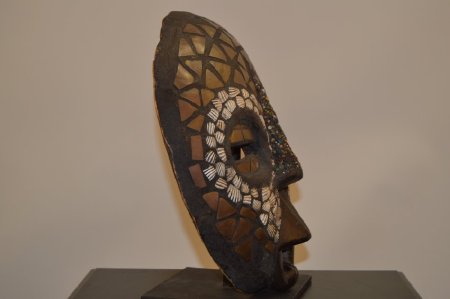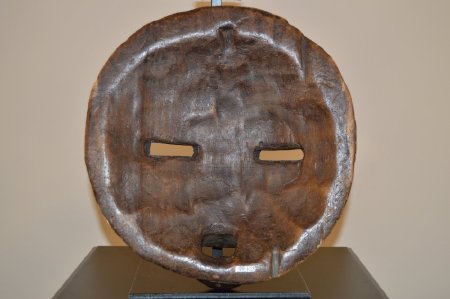Title:
Songye—Luba Style, Kifwebe Mask
Object Name:
Mask, Songye, Luba
Other Name:
Mask, Songye—Luba Style, Kifwebe
Place of Origin:
Songye—Luba Style, Democratic Republic of Congo, Africa
Provenance:
Aboriginal Indigenous Art.
Kifwebe masks were made for the Bwadi Bwa Kifwebe association, a type of policing society that provided a means of controlling social behavior and neutralizing disruptive elements within the group. These masks appeared at the installation and death of a chief, and at the initiation rites of young men as well as a whole range of occasions that included punishments, warfare and public works. There is great variety and symbolism within the various Kifwebe masks. More than thirty different mask names have been recorded. Several have animal names while other masks have names of illnesses like leprosy or names denoting natural phenomena. For the most part Kifwebe masks no longer function to maintain social control among the Songye except in the southeastern regions bordering on Luba territory.
Songye origins are shared with the Luba through a common mythical Songye ancestor known as Kongolo, who can be traced through lineages to the 16th century. The linguistic traditions of these neighboring peoples are intertwined as well. It is believed that the founders of the Songye emerged from the lake region in Shaba province to the south in the heart of the Luba homeland. The Lomani River divides Songye territory and marks the boundary of the areas invaded by the Luba. As a result of these geographic and political differences there emerged two distinct social structures among the eastern and western Songye and two stylistic differences in art forms between the two areas.
Kifwebe masks were made for the Bwadi Bwa Kifwebe association, a type of policing society that provided a means of controlling social behavior and neutralizing disruptive elements within the group. These masks appeared at the installation and death of a chief, and at the initiation rites of young men as well as a whole range of occasions that included punishments, warfare and public works. There is great variety and symbolism within the various Kifwebe masks. More than thirty different mask names have been recorded. Several have animal names while other masks have names of illnesses like leprosy or names denoting natural phenomena. For the most part Kifwebe masks no longer function to maintain social control among the Songye except in the southeastern regions bordering on Luba territory.
Songye origins are shared with the Luba through a common mythical Songye ancestor known as Kongolo, who can be traced through lineages to the 16th century. The linguistic traditions of these neighboring peoples are intertwined as well. It is believed that the founders of the Songye emerged from the lake region in Shaba province to the south in the heart of the Luba homeland. The Lomani River divides Songye territory and marks the boundary of the areas invaded by the Luba. As a result of these geographic and political differences there emerged two distinct social structures among the eastern and western Songye and two stylistic differences in art forms between the two areas.
Description:
Large wooden, circular, Kifwebe style mask. Protruding wedge—shaped nose, extending to center of forehead. Rectangular pierced eyes, in circular concave orbits. Protruding U—shaped lower mouth, with groove on central bottom lip and flat upper lip. Small pieces of shell, beads and metallic—colored triangles, cover entire facial area. Dark brown patina covers remainder of surface area.
Collection:
Marianne Keown Collection
Material:
Wood W/Patina, Beads and Shells
Used:
Ritually Used
Technique:
Carving / Painting
Owned:
Art Department, Missouri Southern State University
Accession#:
2015.3.37



